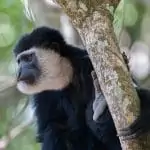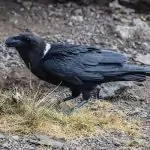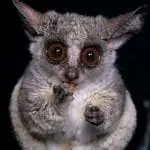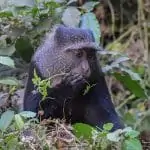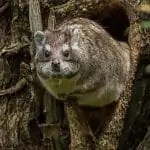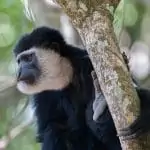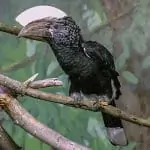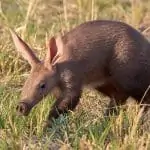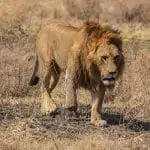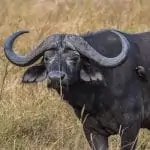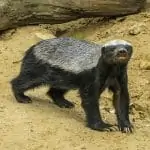Kilimanjaro is a wonderful place, full of life in all its forms, but one thing you may notice on your Kilimanjaro climb is the relative lack of wildlife. There are two reasons for this:
- Most of your Kilimanjaro climb is going to be at altitudes that are higher than most animals can’t survive in
- As a rule, animals avoid people.
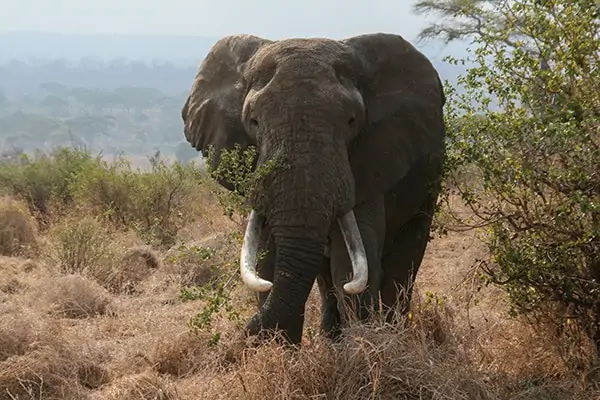
For decades, people have swarmed over Kilimanjaro, and more come every year. This means that even the more habitable areas surrounding the mountain tend to be devoid of animals, compared to the rest of Tanzania. So if your goal is to see some of African’s famous animals in their natural environment, a safari in the Serengeti, Ngorongoro Crater, Lake Manyara or Tarangire National Parks would better suit the purpose.
This does not, however, mean that your climb is going to be a joyless trek, lacking in color and life. You can still get your animal fix on Kilimanjaro, but unlike safari zones, you’ll need to work a little harder for it. Keep your voice down and your head up, and you may spot some creatures along the way, assuming you know what to look for. Here are a few of the animals you’re likely to run across on your Kilimanjaro trek.
Zone One: Cultivated Zone
Zone one is the Cultivated Zone (800m – 1800m). It really only on the southern foothills and is covered in coffee plantations.
Zone Two: Jungle / Rainforest
Understandably, different ecosystems contain different animals, and you’ll pass through five distinct ecological zones on your way up the mountain. The first you’ll pass through on your trek is through is jungle rainforest. The good news is that, like any wooded area, there are definitely animals here. The bad news is that most of them are prone to hiding from people, and there are lots of things to hide behind. More often seen toward the cultivated areas prior to the rainforest, galagos (also known as bushbabies) can be heard, if not seen. These cute little guys look like a cross between a squirrel and one of your sister’s old stuffed animals with the huge eyes. There are also tree-hyrax, which are technically distant relatives of elephants, but actually resemble something closer to a mongoose.
Once in the forest, you’re likely to see blue monkeys, who aren’t really bothered by humans, but don’t let the name fool you – they’re generally gray with a white throat. What you really want to keep an eye out for is the colobus monkey, which is fairly shy, by comparison. Your best shot at catching a glimpse of one of these beauties is to keep the noise level down and watch the trees for flashes of black and white. The easiest thing to spot about the colobus monkey is definitely its tail; it’s so long and flowing that you could almost be forgiven for mistaking it for white moss hanging from the trees. Both of these primates are most likely to be seen on the Rongai route (north side of the mountain).
Although it isn’t likely, you could run into an aardvark at the lower elevations. There’s nothing to fear from these odd-looking creatures, as they’re nocturnal and pose no threat to humans. Honey badgers, on the other hand, are dangerous, and in the off-chance that you spot one (they often look like a cross between a skunk and a weasel), you should definitely keep clear – there’s a very good reason they don’t have many natural predators.
Zone 3 -5: Heather-Moorland / Alpine Desert / Artic or Summit
Once you pass through the forest, you’ll be in the Heather/Moorland zone. Here you’re a lot less likely to notice any wildlife, but there is one major exception – the four-striped grass mouse. It’s one of the only creatures that can survive at higher altitudes—and where there are humans, there is food—they’re not as terrified of us as most other animals usually are. You may well see them at the camps since mice will often find shelter inside of the Horombo Huts. Above this zone there are the Alpine Desert and Artic or Summit zone. The only wildlife that you will spot frequently now will be the White-Necked Raven.
“..Close to the western summit there is the dried and frozen carcass of a leopard. No one has explained what the leopard was seeking at that altitude.”
Fact or Just Tall Tales
There have been some unusual sightings on the mountain.
While all this was happening on Mawenzi, over on Kibo another man was writing himself into the history of Kilimanjaro: Pastor Richard Reusch. Missionary for the Lutheran Church, former officer in the Cossack army and long-time Marangu resident, Reusch climbed the mountain on no less than 40 different occasions.
During his first attempt of the summit in 1926 he discovered (or rediscovered, there being some dispute as to who saw it first) the frozen leopard on the crater rim that would later inspire Hemingway (Reusch cut off part of an ear as a souvenir), while on another sortie the following year he became the first to gaze down into the inner crater, a crater that he was later to give his name to.
Ernest Hemingway (1899 – 1961) wrote in his prelude to the book “The Snows of Kilimanjaro”: ‘…Close to the western summit there is the dried and frozen carcass of a leopard. No one has explained what the leopard was seeking at that altitude.’
Hemingway claimed to have seen this leopard when he climbed Kilimanjaro via the western summit, and even claimed that he took a piece of its ear as a souvenir. The leopard has long since disappeared from the mountain, and it is disputed whether it was even there in the first place. Various arguments have been put into place; perhaps the leopard was chasing an antelope and got lost in a blizzard, or maybe it was only carried there by an eccentric climber wanting a bizarre photo opportunity? Whether the leopard was really there or not we will never know.
On another occasion, in 2011 a group of four tourists reported seeing a dog near the summit. One of the climbers took a photo. A Kilimanjaro Guide said he say the same dog near the Barranco a decade earlier.
Additional Animal Sightings
If you’re on the Rongai route, you may have even better luck – because of the nearby Amboseli National Park (on the Kenya side of the border), elephants and a few other animals often wander toward the mountain. Lions have been known to occasionally appear on the Shira plateau, but they’re pretty rare, although you might have a better chance of seeing some buffalo. There is a well-preserved buffalo carcass along the Rongai route.
If birds are what you’re looking for, then you can cheer up, because there are birds almost everywhere around the mountain. In fact, there are so many that we can’t list them all here, but there are a few to look for. One that will likely end up looking for you is the white-necked raven, which lives on scraps left by tourists around the various campsites. They look a little scary, but if you don’t get between them and their food, you’ll be fine. Of more interest is the silvery-cheeked hornbill, which you’re most likely to find near fruit trees. If you’re really lucky, you might catch a glimpse of a malachite sunbird. These little guys are found around the flowers where they feed. You’re most likely spot the males – they’re black, mingled with metallic green, and little scarlet tufts on the sides, along with a long skinny beak that hooks down slightly at the end (the females look the same, but with brown coloring).
In conclusion, if animals are your prime focus, a safari would be highly recommended. But, while you shouldn’t expect your Kilimanjaro climb to be a trip to the zoo, there are certainly opportunities to get some snapshots of the local wildlife.


